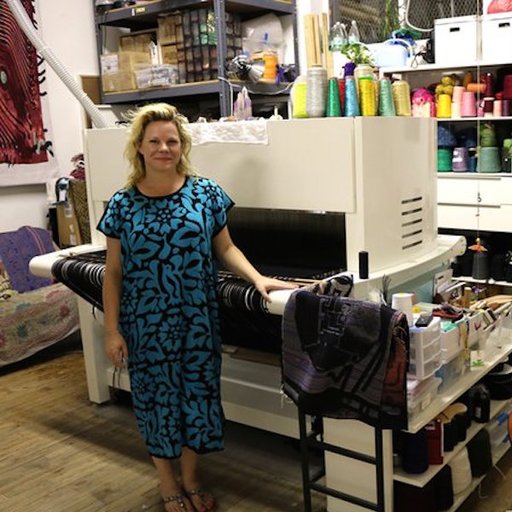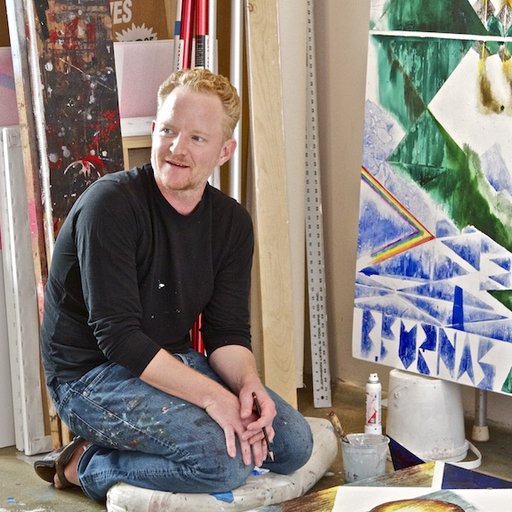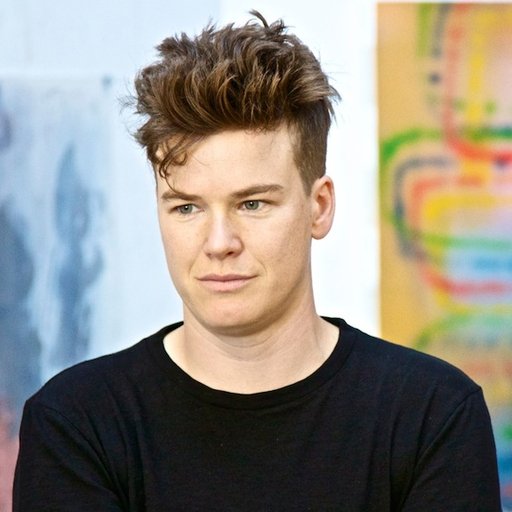If Ridley Scott ’s Alien franchise produced a ballet, it might take some cues from Ivana Basic ’s current solo show at Annka Kultys Gallery in London. Pastel pinks and periwinkle blues give the show a soft, girlish feel, though the source of these pale hues—bruised flesh on disfigured bodies—suggest that graceful beauty is probably not the take-away here.
A figure arching in arabesque, supported from the ceiling by blush pink straps, lacks the feet or torso to support itself. Nearby, a steel rod penetrates two twisted figures, pressing them into opposing walls as they fold over themselves. Many viewers might be unsettled or even disgusted by these precarious wax forms, which for Basic, really isn’t the point, but it certainly helps her case. For Basic, who grew up in war-torn Serbia, our understanding of a “healthy” body is completely ideological. Basic's sculptures project our socially constructed notions of the disabled body; if we see them as grotesque, it's only because we've been socialized to perceive deformity as a failure to perform work and thus contribute to a capitalist system.
Artspace’s Loney Abrams spoke with Basic in her Brooklyn studio about the digital and material ways the artist has alienated herself from her own body, about the ever-present existential fear that she experienced growing up in Serbia in the '90s, and about her plans for an upcoming group show at the Whitney .
 Courtesy of the artist and Annka Kultys Gallery
Courtesy of the artist and Annka Kultys Gallery
You have a solo show currently up at Annka Kultys Gallery in London, called Throat Wanders Down the Blade . You’re showing some new sculptural work as well as a book, which has original drawings, and is loosely based on a character called Bridle. Who is Bridle?
Bridle is a character. She came out of trying to name and address these two forces that I have been employing in my work—one being this force that propels life forward and creates life, and the other one that suffocates life in order to bring its fragility to the surface. Those two things have always been present in all of the works, playing the role of both the blade and the wound. So I decided to name and embody these two forces in one persona. The whole show is based around the materialization of Bridle through body —which would be the sculptural pieces… three forms through which she moves around; then there’s the breath , contained in the glass vessels hanging on the walls; and then there’s the voice , which is really in her words in the book.
 Coutesy of the artist and Annka Kultys Gallery
Coutesy of the artist and Annka Kultys Gallery
The book is a narrative, a novel?
No, not at all actually. It’s really about Bridle’s experience of being within these bodies. The sculptures themselves were made in a way that situates the visitor as the intruder, because they’re addressing these two internal states that are now being externalized, materialized, and given the body. The figures are not really supposed to be exposed to the outside, which is why one of the pieces is hiding its head behind its own ribs, the other piece is turning its head away from the viewer, and the third piece doesn’t have a head at all so that it can’t be witnessed. So the voice is pretty much doing the same thing—it’s written in a way that is almost like it was never spoken, because once you speak it you construct it for someone’s ears. The sentences are very broken, it’s like unspoken thoughts about the experience of being in each of those pieces, describing what it’s like to be inside a body, and to look through your own ribs and see the light as it passes by and feel the smell. So it’s really there to pull you inside.
What are people’s reactions, usually, to seeing the wax figures?
They’re really different, honestly. I think one thing that is definite is that pretty much everyone has a reaction. A lot of people, you know, think they’re pretty intense, and some of them think they’re grotesque or morbid. A lot of people reference
David Cronenberg
, [a filmmaker known for originating the body horror genre]. But then there are people who see past that. It depends how deep your knowledge is and how deep you can go.
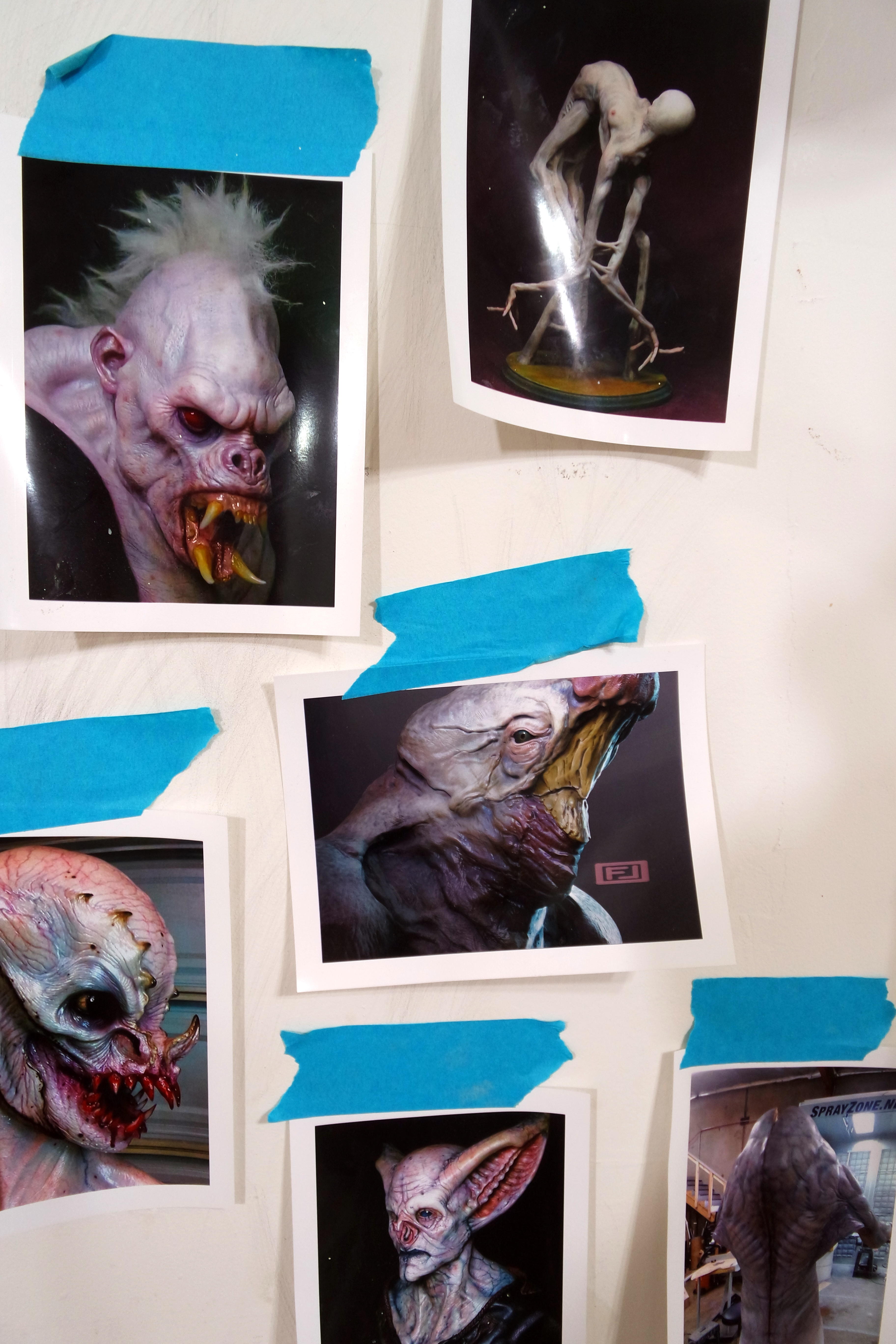
The figure, art historically, has generally been a celebration and appreciation of beauty. Your pieces seem to express something else, maybe the fragility, the vulnerability of the human body. Is sickness a metaphor for you?
But they’re not, that’s the thing. They’re not sick-looking, they’re not injured, they’re not wrong. They are not wrong. They are exactly as they should be. It is our handicap that we are unable to perceive anything that differs from the normalized body as something that is whole. Society has constructed our mindset so that we can only perceive a normalized body as a full body. Everything that is more or less than that is deformed. It is abnormal, and therefore insufficient, in a way. And really, the body in society is controlled. Even hygiene is a way of control over the body. So whenever the body starts to come to the surface, it is very disturbing for people, because the body is not supposed to overpower the man. So what I’m doing is I’m allowing the body to be what it is, without being normalized by the man. And I find that really beautiful, and I find it very true, also.
And I think also, in a way, for me, that all of my pieces have these bruises—and the reaction is like, “Oh, are they injured?”—but the bruising is really something that doesn’t come from the outside; bruising comes from the inside. It’s completely internal; it’s basically an attempt to escape the body, and you’re hitting the surface of the skin, and you’re bruising on it. So there’s an attempt to escape the body, escape the matter, escape the finity of it, and the bruise is the failure to do so. And, in a way, people say you want to protect what is beautiful, so I tried to make them really beautiful, to keep them away from the gaze of others, to protect them.
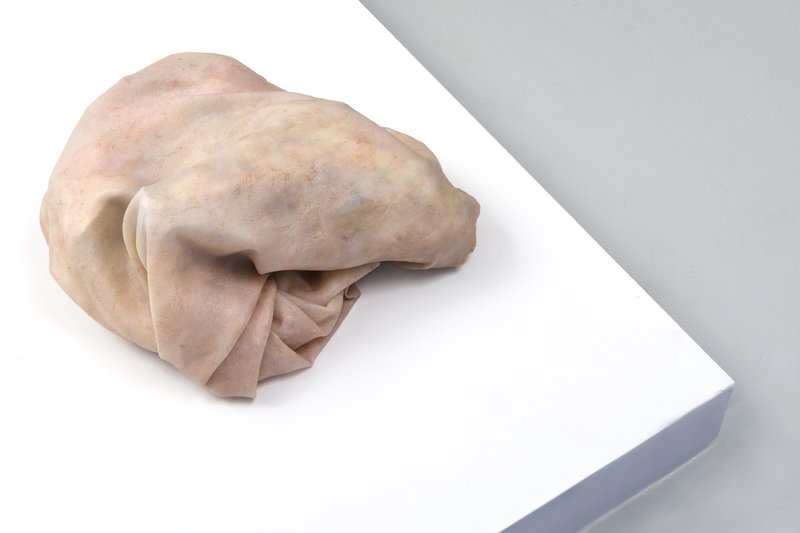 Ivana Basic's
In my scarred fevered skin you see the end. In your healthy flesh I see the same #2
is available on Artspace
Ivana Basic's
In my scarred fevered skin you see the end. In your healthy flesh I see the same #2
is available on Artspace
Here’s a quote I found on your website, that I assume you wrote: “Life of the body exists only in prenatal and postmortem states.” Is that something you can explain?
Yeah, that was from one of my thesis papers. It references this thinking about man as sort of a societal construct. Normalcy of the body is defined by the economics of labor. So the abled body is a body that can work, therefore it has two hands, two legs. And then everything that is not that is disqualified, and it is disqualified in a way that makes it not different, but less . And the language has made it so that you can’t even refer to it without saying disabled, handicapped. All of those are degrading. They’re referencing it as less. So I was dealing, in that text and in my thesis, with that understanding. Like, what constitutes a normal body and how come we cannot perceive what body is when it’s not controlled by the man. You go to the bathroom—this space which is totally sterile—you go there to clean your body so that others won’t perceive it, so you won’t perceive it. As soon as body starts to rise up, which would be a handicap that people will stare at, or if you start to smell or your nails start to grow, you will be disqualified from society because body’s not supposed to overpower you.
So the whole text was basically going toward an understanding where the only times when the body really exists is before you’re even born, before you enter this societal system of controlling it, and then once you die, which is when you really turn into matter, and then the body…I don’t want to say, blossoms, becomes what it really is, which is what it was the whole time. Throughout our lives, we have learned to not look at it and to not live with it, as such.
 Coutesy of the artist and Annka Kultys Gallery
Coutesy of the artist and Annka Kultys Gallery
What are you influenced by?
I don’t have a specific thing I’m influenced by. I’ve had these thoughts, and I’ve experienced things myself. I guess the experience of living where I lived and going through all the contexts where you really know the fear, where you really know what life is, because everything else is taken away… when you are just sort of left with your life. The situation of political conflict or war brought this clarity of what life really is once you take everything away. It’s an irreversible point. That is something that is just there as a base for me, and I recognize things that go along with that and extend that.
The writing in the book [exhibited at Annka Kultys Gallery] came from me and writer
Courtney Malick
, who worked with me on the book. My voice consisted of my own and the voices of
Kafka
and
Nabokov
. In just the past few years I have been reading them intensely. They are people who have experienced the world in the same way. I find comfort in their words which are pretty much words that recognize that we live in this vessel that is going to expire and we will expire together with it, and there’s a kind of failure to identify with this vessel, which is pretty much what is my case. So that really gives me comfort, in a way. I wouldn’t say it influences or inspires. It just informs my perspective.
[related-works-module]
A lot of your titles are pretty dark…
The voices are becoming quieter and fewer
, or
In my scarred fevered skin you see the end.
Would you consider yourself a dark person?
I don’t know. Dark is… I don’t really know what is dark, you know.
You take comfort in knowing your body will expire. Maybe dark isn’t the right word. Maybe morbid is better?
Morbid has a very negative connotation because you have been taught to think about finitude and death with a very negative connotation, because life is supposed to annihilate death in a way because they can’t coexist. So, I don’t think so. I think all of my figures have a certain kind of awareness. I think they are very aware and I think they are very awake. And I think those are the things that happen once you face the fear and face the reality. And if you call that morbid, then yeah, I guess so.
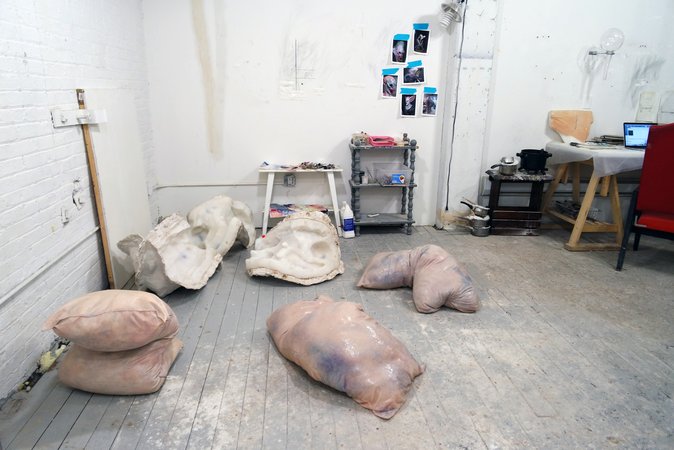
You’re really good at making things that are very viscerally body-like, very corporeal, without being overtly human, necessarily. And it seems like you have two different kinds of vocabularies to do this with. You have these figures that are very much rooted in the medium of sculpture—they’re handcrafted, they’re labor intensive, they’re tactile. And then you also have this body of work that’s more in conversation with the net art vernacular and new media. Your video work, your digital prints on acrylic, even your social media presence…
Yeah, I think all of it is exactly the same thing. The medium is not the message in my work. The message, depending on which angle you look at it, finds the medium in which it needs to manifest itself at that moment with that specific aim. But the digital work has nothing to do with net art or anything else. I think it just happened to correlate at the moment when net art was happening. But the whole aim of the digital body and that whole
SOMA
project was to pretty much do the same thing I’m doing with all these other pieces. The for idea for
SOMA
was to create a digital replica of myself that is pretty much indistinguishable from my physical body, and then to sell that body online and allow people to do whatever they want with it. And in that way I sort of denounced any relationship between my body and my identity. I would almost overcome that body, like it would have no relation to me. I could see it in a 3D porn, in an advertisement, somewhere else, and it would stop representing me. So it was just another way to escape the skin, really.
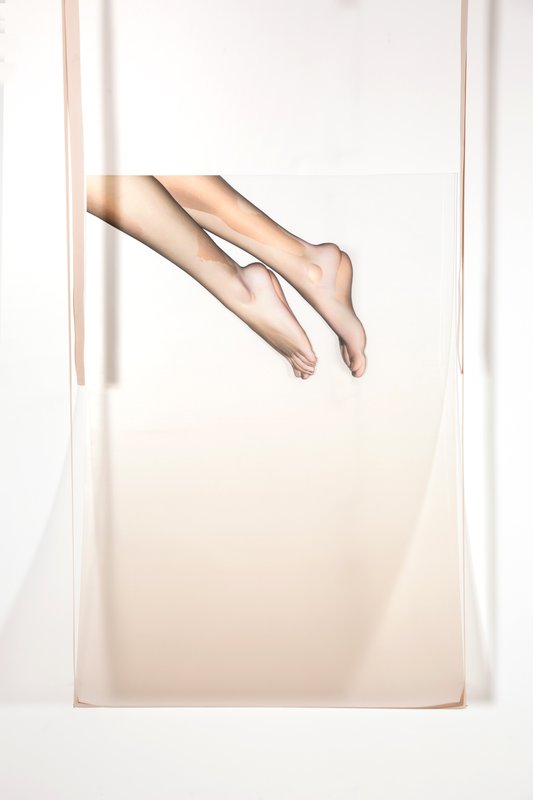 Ivana Basic's
Das Unheimliche #3
is available on Artspace
Ivana Basic's
Das Unheimliche #3
is available on Artspace
Where is your source imagery coming from for your video work?
Many different places. Most of the video work that I was doing in the beginning was really me performing. But I obscure it, de-gender it, and make it very universal, ghostly, and a little bit of an alien presence. Then later, I started using 3D models and started breaking the body and warping it. The thing is, I’m always looking for a feeling. Like, I think the way you consume this work is really experiential and really emotional. Obviously it is intellectual, but I think that is the first thing that gets to you and that’s what really drives me. I don’t stop until I can feel it when I look at the work.
So that emotional response is pretty much the most important thing to me. Growing up in Serbia… there is no art there, pretty much. There is no art scene, there is no infrastructure, there are no artists, there is nothing like that. The people I want to communicate with are not people who only went to art schools. It’s really everybody. I think my work is fundamentally true for everyone and I want them to be able to get to the work. I mean, to the extent of their own understanding obviously. But I don’t want to make work that is artistic and only talks to the art crowd.
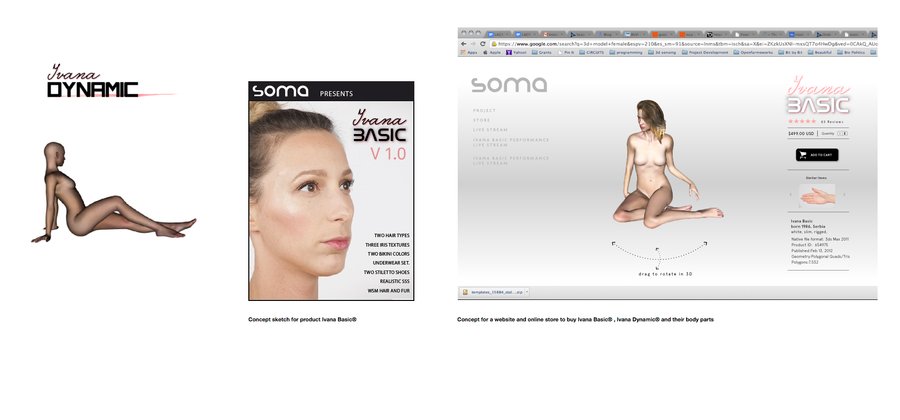 Basic's
SOMA
project renderings, screencaptured from her
website
Basic's
SOMA
project renderings, screencaptured from her
website
Can you talk a little bit more about growing up in Serbia? When did you move to New York?
I moved around 6 years ago here. I spent my whole life in Serbia. Serbia doesn’t really have infrastructure to support artists so I sort of had to leave, and I came here to do my Masters. I lived in Belgrade. I grew up during the ‘90s where there was war. There was a lot of instability. I was there during the bombing in 1999. So the atmosphere that I’ve always known has been really one of, I would say, existential fear. Like a very raw reality that is very stripped of anything. So people are much more direct, and language is much more direct. There is no reason to wrap it or to make it more enjoyable or anything. Everything is very bare and I think that really gives you a certain sort of perspective that influenced who I am and what I do. It wasn’t singular events—like a traumatic bombing or whatever—it was really the atmosphere. And whenever I go back, with all the people who are there, I have the most incredible conversations because it’s really a very specific kind of wisdom that raises when life is not very enjoyable and just bare and empty.

Switching gears, let's talk about your process. How do you make these forms?
I start from a very vague idea. It’s just these drawings on the wall—this is really all I have. There is no 3D modeling, there is no nothing—it is really this very vague drawing . It’s a pose, gesture, and emotion—just those three things. From there, everything is really searching. I’m pretty much like a person completely in the dark. I start working with clay, building the volume out of clay, and then I’m looking for the form. And that lasts anywhere from five to seven months. I would fully scrape them and reshape them, because I don’t really know until I see it. And the funny thing is, the finished forms pretty much end up being exactly what I drew in the beginning. It's a lot of searching, and then once I find the pose and see that I can extract the emotion, then I go into detailing.
Even though those bodies are not normal bodies, there is a very solid internal logic to the way they exist. There is a skeleton that has its logic, so everything really needs to work with that. So I start sculpting the details and sculpting the little cuts and traumas, and then after that I do mold making. I make molds, and then I cast in wax, and then after that I paint with oil paint on top. Some pieces get the silicone layer, some don’t. A lot of it is just very intuitive. I always knew I wanted to transition into working with the glass. I know the properties of the material and why I’m using it, but I didn’t quite know how it’s all going to play into my work, and then it just all sort of fit perfectly in this way. So, I let it lead me, really.

You have a really exciting show coming up at the Whitney , a group show. What can you tell me about it?
Yes, so it is a show, Dreamlands , that Chrissie Iles has been working on for a long time now. And it is, basically, a progression of immersive art, image, and the body, from 1905 to 2016 and the way they have influenced each other and progressed through different technologies. And then I guess, in the curatorial narrative, there is a chapter about the cyborgian body, which is really where my commissioned SOMA piece comes into play.
I have two pieces in the show. I have the wax piece, which is actually the one in my studio right now. And I have the video piece, which is going to be projected as if it is a person in the space. The projection will disappear, and it’s going to be life-size, performing this kind of impossible choreography because it is made out of a digital body that doesn’t really have boundaries. So I have that, and the wax piece sort of opposed to each other. One is really bound to the matter, and the other one is really existing outside of the matter and, in being digital, becomes, in a way, borderless. But also that borderlessness brings a certain kind of potency to it and I would say can generate a certain kind of fear because it would render it uncontrollable in a way. So it is a subtle play between the two pieces.

The way you talk about your work challenging societal ideals of the perfect body is interesting to me in the context of many women artists who are working seemingly under the same pretense but are expressing the idea in such a different way—through Instagram, through selfies, through anti-censorship rhetoric, through posting photos that flaunt what are largely perceived as flaws for women—like body hair, blemishes, cellulite, etc. as a means of taking ownership of and control over how women’s bodies are portrayed. In a way, your work seems to have a similar goal, though it's maybe less tied up with gender.
Yeah. I think is very surface-level and the other one is very fundamentally existential. Like, “this is what I’m in” as opposed to “this is the surface of me and how do you perceive it.” It’s appearance as opposed to substance and the two are totally different. It ties a lot with the materials I use for example, wax and glass and oil paint can always re-melt or re-dilute into an original liquid state, back into the matter; the final form is not the definitive state of it. So in a way it’s avoiding the death of the material, or going around it. And for the glass and the wax, the state where they can actually be solid, is also the most fragile state. In contrast to that I use silicone and in this past show I used faux leather, things that in my mind that have a quality that can simulate skin, simulate reality, but are artificial. I think skin is one part of yourself which you construct. It is a constructed part of you. It’s the way you appear to others and the part that you control. So in that way, it’s a simulation, which is why I use materials that are not real.
[related-works-module]

















